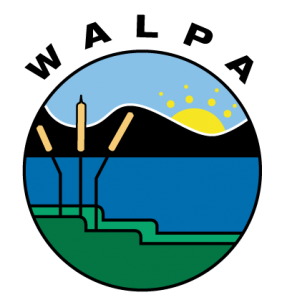 WALPA’s Mission:
WALPA’s Mission:
Our mission through WALPA is to allow diverse interests to speak with one voice to protect lakes. We encourage and support programs for lake and watershed protection, restoration and management, provide educational resources and information about lake and watershed management, and foster communication and coordination among lake and watershed stakeholders
Purpose
The Washington State Lake Protection Association (WALPA) is scoping the present need and opportunity for developing a statewide volunteer lake water quality monitoring program. The purpose of this program is to provide consistent long-term data and information on Washington lakes that can be used to meet the needs of various management, scientific, and educational institutions.
Background
History of statewide lake monitoring in Washington
From 1989–1997, a statewide lake water quality monitoring program was led by the Department of Ecology (Ecology). With assistance from volunteers, Ecology monitored about 60 lakes each year. Funding for the program has since stopped. Ecology’s lake monitoring programs have evolved to measure toxic chemicals in fish tissues and in sediment cores, and to survey aquatic plants. Currently, however, Washington still lacks an organized, consistent long-term statewide program to monitor basic water quality parameters in its lakes.
Why do we need statewide lake monitoring?
Lakes are important natural resources and an integral part of Washington’s scenic landscape. They provide recreational opportunities including fishing, swimming, boating, hiking, and other outdoor activities; are reservoirs for our drinking water; and provide habitat for a diversity of fish and wildlife.
It is well-recognized that human activities can inadvertently lead to the deterioration of water quality in lakes, resulting in lost recreational opportunities, increased vulnerability of our drinking water supplies, and decreased fish and wildlife habitat. In Washington, common lake issues include:
- High nutrient levels from polluted runoff, leading to toxic and non-toxic algal blooms.
- Invasive species, which can displace native species and become a recreational nuisance.
- Runoff and deposition of toxic chemicals, which can bioaccumulate in consumable fish.
- Elevated bacteria levels, which can affect human health and lead to swimming closures.
Less is known about how climate change may affect the functioning of lake ecosystems, and how lakes are currently managed.
Washington contains nearly 8,000 lakes. Water quality data exist for a small fraction of these lakes, and an even smaller fraction have been consistently monitored over time. To assess and prioritize how we manage lakes and how we invest our time and financial resources in addressing lake water quality issues, we need a consistent and reliable dataset for lakes across Washington.
Although various local and regional lake monitoring programs exist, a statewide program differs in scale and scope in terms of questions, objectives, and design. A statewide program also ensures some level of consistency in sampling methods and frequency, laboratory analyses, and quality assurance. Statewide coordination is important as we face questions and challenges that extend beyond the local scale, and that affect how we make decisions to protect our natural resources.
Proposed Activity
WALPA seeks to continue efforts begun by Ecology over 25 years ago by coordinating a volunteer-driven statewide lake water quality monitoring program.
Program Goal
The main goal of the program is the collection of long-term, consistent, high-quality data from lakes across Washington. The resulting dataset will contribute information and understanding that could help:
- Establish baseline information for lakes with little or no monitoring, which could be used to help distinguish between natural variation and human influences.
- Interpret long-term trends within lakes and spatial variability among lakes.
- Identify emerging or potential water quality issues before they mature.
- Provide sufficient data to determine whether water quality meets regulatory standards.
Monitoring Objectives and Design
To achieve its goal, WALPA will collaborate with stakeholders to define specific monitoring objectives and build a monitoring framework. A detailed monitoring plan will include:
- Selection of lakes
- Selection of water quality parameters to collect
- Standard field and laboratory methods
- Quality assurance procedures
- Data collection, assessment, and reporting procedures
- Sampling schedule
- Program evaluation
Program Strategy
The magnitude and scope of the proposed activity requires the collaboration and coordination of multiple stakeholders throughout Washington. With active and experienced members from diverse professional and educational backgrounds, and a long history of lake advocacy, WALPA is well qualified to coordinate this effort. WALPA envisions partnering with local and state governments, educational institutions, non-profit organizations, and local citizens to develop and sustain a volunteer-driven statewide lake water quality monitoring program. Water quality experts and professionals will guide the program and provide most of the tools and training necessary for volunteers to conduct field monitoring.
Many benefits arise from a collaborative, volunteer-driven effort. Teaming up with active and trained volunteers is a cost-effective way for states to fill major fundamental monitoring gaps. A volunteer-driven effort engages local communities in environmental stewardship. Partnering with local citizens and educational institutions promotes education and awareness about a variety of scientific methods and lake water quality issues. All of these enhance support for the protection of Washington’s lakes.
Next Steps
WALPA 28th Annual Conference—Visioning Session
Conference registrants can learn more or join in the discussion on Tuesday, October 27 at 4:00 pm (Session 4: WALPA Planning for the Future). Topics may include specific statewide monitoring needs, building a monitoring framework (e.g., monitoring objectives and design, program structure, and designated roles), funding, practical constraints, and any other items. Ideas generated from discussion will help WALPA develop a detailed monitoring framework.
Getting Involved
As the process evolves, there may be different ways that any individual or group can support WALPA’s effort in advocating for statewide volunteer lake water quality monitoring. Individuals interested in volunteering or becoming involved in other ways should contact Siana Wong at sianawong@gmail.com or Jim Gawel at jimgawel@u.washington.edu.









